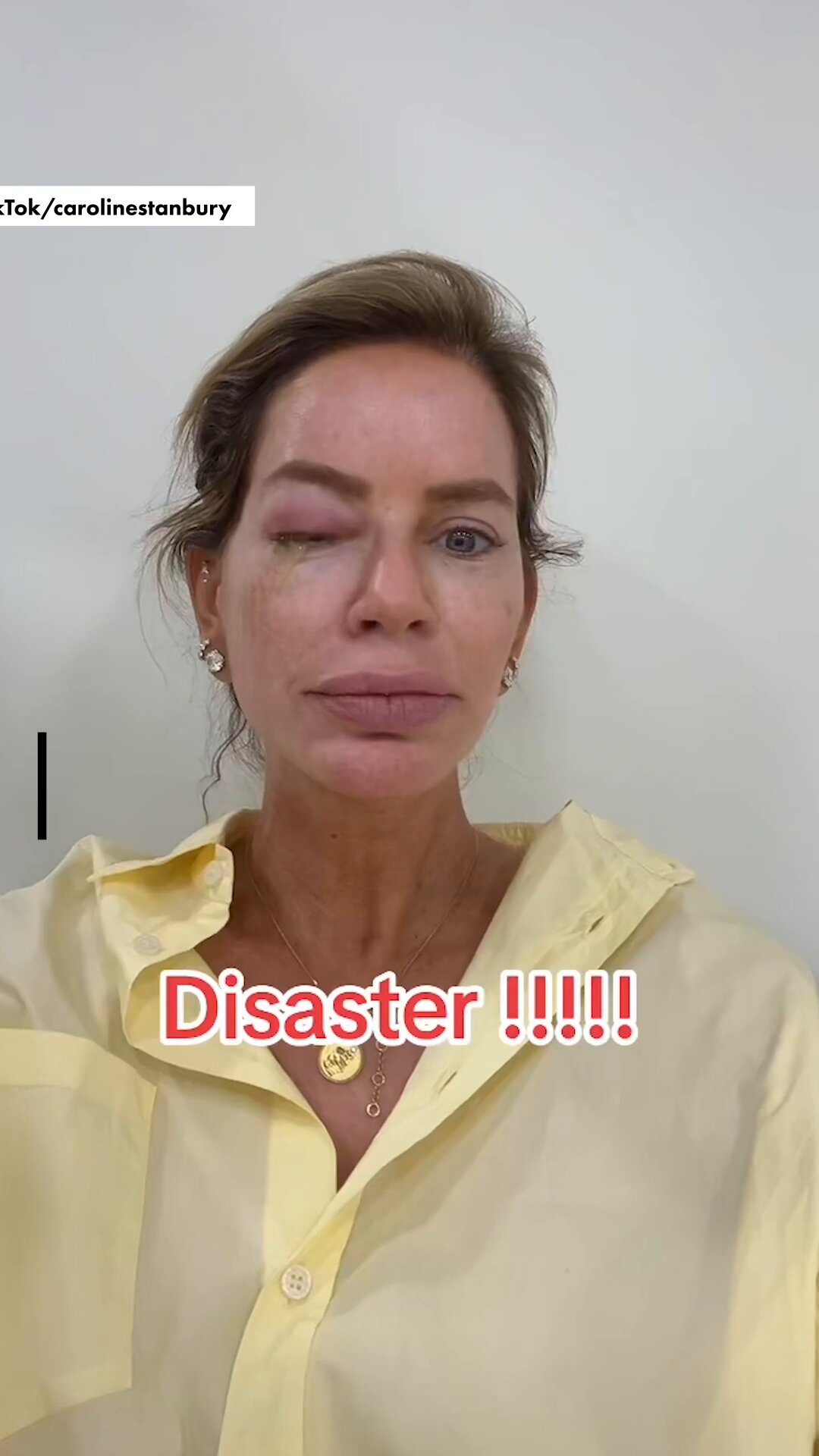Caroline Stanbury Battles Severe Eye Infection, a star of “Real Housewives of Dubai,” expressed her concern, saying, “I’m not going to lose an eye, am I?” as she shared her experience with a severe eye infection.
Stanbury has been openly documenting her challenging journey with this painful condition. On February 19, she posted a video on TikTok, revealing that she woke up to find her eye swollen shut and “oozing.” The 48-year-old attempted to alleviate the issue with eye drops and antihistamines, but unfortunately, these remedies proved ineffective.

“It has worsened, not improved,” she stated in the video. “We are now at the hospital. I probably should have sought help a few hours earlier, but I didn’t anticipate this outcome.”
“I cannot comprehend this; I have never encountered anything like it. It is genuinely oozing, and now I have a headache. This is absurd,” she remarked, describing the situation as a “disaster.”
Her husband, Sergio Carrallo, expressed his prayers for her recovery, to which she responded promptly, “What are you praying for? I’m not going to die. I’m not going to lose an eye, am I?”
@carolinestanbury Am I that difficult? 🤭 @Sergio Carrallo #angry #nurse ♬ original sound – Caroline Stanbury
The next day, after a “terrible” night, Stanbury provided another health update from home, indicating that she was returning to the hospital for further treatment, which included antibiotic injections and an MRI to assess the swelling.
“It is extremely painful. You can see how severe it is,” she noted, sharing a close-up of her affected eye.
“This is unbelievable. The pain has been intense, with no signs of improvement. It truly feels as if my eye might burst,” she added. “There is a burning sensation, as if my eyeball is on fire. I have been informed that this could persist for two weeks.”
Later, Stanbury disclosed that she had been diagnosed with orbital cellulitis.
Orbital cellulitis is a bacterial infection affecting the skin, fat, and muscles surrounding the eye, as explained by the Cleveland Clinic. If not treated promptly, it can lead to severe and lasting complications, including blindness. Symptoms typically include swelling of the eyelid and surrounding skin, bulging eyes, discoloration or redness, and pain.

The reality television personality expressed confidence that she “will be fine” and confirmed that there is no lasting harm to her eyes. Stanbury also extended her gratitude to her followers for their kind messages and recommendations regarding her eye condition as she chronicled her recovery.
“I am on the mend,” she stated.
On February 23, Stanbury posted another video on TikTok showcasing her improvement, proudly noting that her eye is “a million times better” and that she can finally open it properly with considerably reduced swelling.
Orbital Cellulitis: Symptoms & Treatment
Orbital cellulitis is a severe infection affecting the soft tissues and fat behind the eye. Unlike periorbital cellulitis, which impacts the eyelid and surrounding skin, orbital cellulitis penetrates deeper structures. While it is not contagious, it demands immediate medical intervention to prevent vision loss or life-threatening complications.
Who is Affected?
This condition primarily affects children, particularly those under seven years old, but adults can also develop it. The infection often stems from untreated sinus infections, though it can arise from other sources such as trauma or systemic infections. Early diagnosis and treatment are critical to avoid permanent damage.
Symptoms of Orbital Cellulitis
Recognizing the Signs
Orbital cellulitis presents with distinct symptoms that can escalate rapidly. These include:
- Swelling and redness around the eye
- Painful or restricted eye movement
- Bulging of the eyeball (proptosis)
- Vision impairment, including double vision or loss
- Fever and headache
In some cases, nasal discharge or tenderness may accompany these symptoms, especially if linked to a sinus infection. Immediate medical attention is essential when these signs appear.
Causes and Risk Factors
Bacterial Infections: The Primary Culprit
The majority of orbital cellulitis cases are caused by bacterial infections, particularly Staphylococcus aureus and Streptococcus pneumoniae. These bacteria often spread from untreated sinus infections into the orbital cavity.
Other Contributing Factors
Additional causes include:
- Infections in nearby areas like teeth or ears
- Trauma to the orbit, such as fractures
- Foreign objects entering the eye
- Post-surgical complications
- Animal bites or insect stings near the eye
Individuals with weakened immune systems, such as those with asthma or immunodeficiency disorders, face a higher risk of developing this condition.
Diagnosis: Pinpointing the Problem
Comprehensive Evaluation
Diagnosing orbital cellulitis involves a combination of physical examinations and imaging tests. Doctors may use:
- MRI or CT scans to assess infection spread
- Blood tests to detect bacterial presence
- Cultures from nasal or eye discharge for specific pathogens
Prompt diagnosis ensures timely treatment, reducing the risk of complications like abscess formation or brain involvement.
Treatment Options for Orbital Cellulitis
Antibiotics: The First Line of Defense
Treatment typically begins with intravenous (IV) antibiotics to target a broad range of bacteria. This approach is crucial given the infection’s potential severity. Once symptoms improve, oral antibiotics may follow for two to three weeks to ensure complete recovery.
Surgical Intervention
In severe cases where antibiotics fail or abscesses develop, surgery becomes necessary. Surgeons may drain fluid from the infected area or remove foreign objects causing the infection. Children are less likely than adults to require surgical treatment.
Potential Complications and Prognosis
Serious Risks
Without prompt treatment, orbital cellulitis can lead to:
- Permanent vision loss
- Meningitis (infection of brain membranes)
- Cavernous sinus thrombosis (blood clots near the brain)
- Systemic infections like septicemia
- Positive Outcomes with Timely Care
With early intervention, most individuals recover fully. Symptoms often begin improving within days of starting antibiotics. However, follow-up care is essential to monitor progress and prevent recurrence.
Preventing Orbital Cellulitis
Key Prevention Strategies
Preventing orbital cellulitis involves managing sinus infections promptly and protecting the eyes from trauma. For those with compromised immune systems, regular health checkups can help mitigate risks.
By recognizing symptoms early and seeking immediate medical attention, individuals can significantly reduce the likelihood of severe complications from this dangerous condition.







